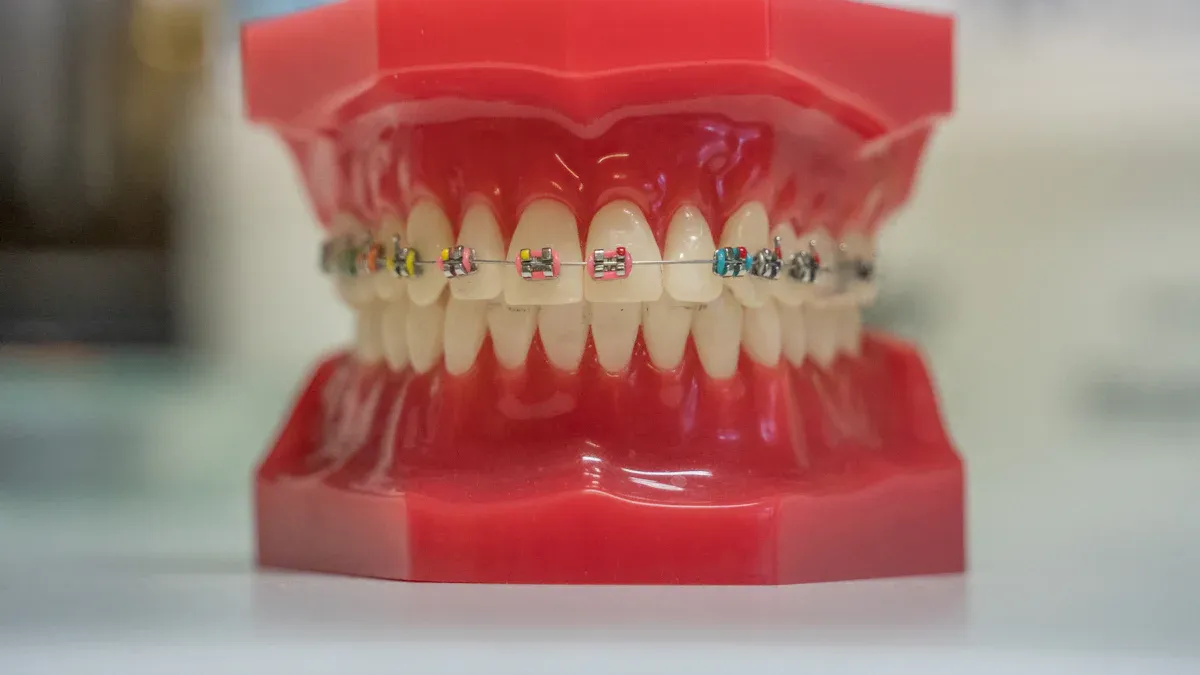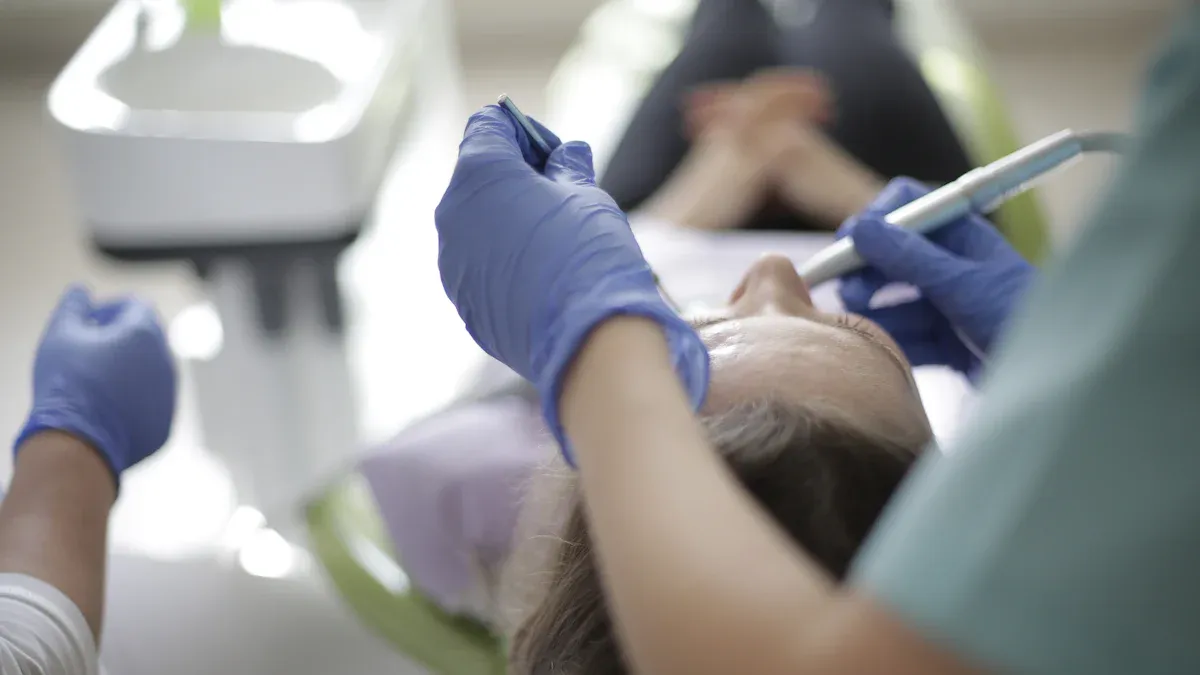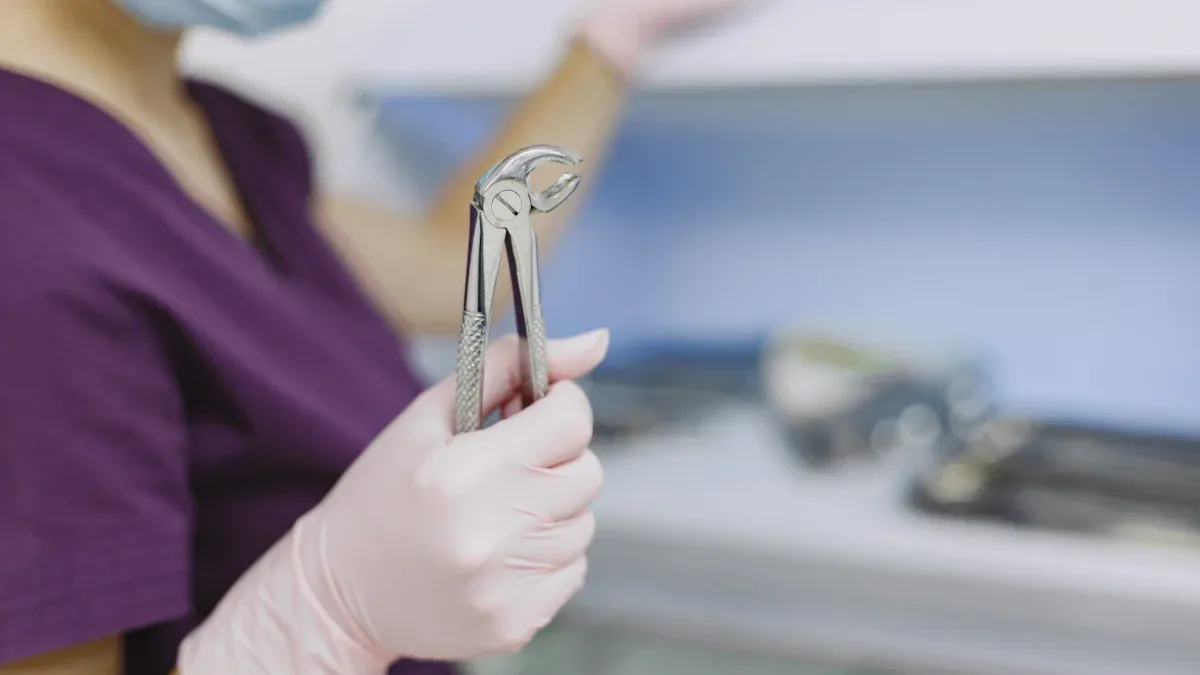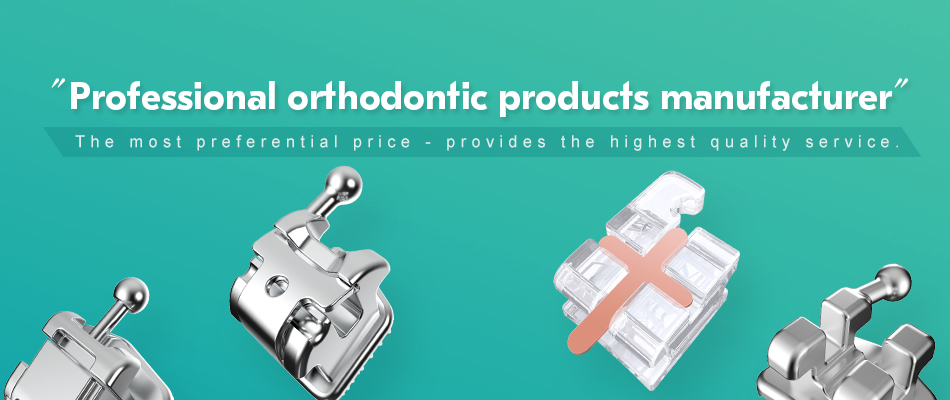
Certifications and compliance play a vital role in the 2025 Global Orthodontic Material Procurement Guide. They ensure that products meet stringent safety and quality standards, reducing risks for both patients and practitioners. Non-compliance can lead to compromised product reliability, legal penalties, and damage to a company’s reputation.
The orthodontic materials market is evolving rapidly, with a projected compound annual growth rate exceeding 10% from 2022 to 2027 in North America. This growth aligns with increasing demand for eco-friendly materials and certified manufacturers. Certifications like ISO 13485 foster trust and innovation, encouraging manufacturers to adopt advanced quality control measures. As orthodontic material sourcing becomes more global, adhering to international standards remains essential for maintaining credibility and delivering high-quality care.
Key Takeaways
- Certifications prove orthodontic materials are safe and high-quality for use.
- ISO 13485 shows a company cares about quality in medical devices.
- CE Marking is needed to sell products in Europe safely.
- FDA approval in the U.S. ensures materials are safe and work well.
- Checking suppliers often helps confirm rules are followed and builds trust.
- Knowing local rules is key to selling products and avoiding problems.
- Using eco-friendly materials is smart as people care about the planet.
- Getting materials ethically improves a brand’s image and follows global trends.
Global Orthodontic Material Certifications

Key Certifications
ISO Standards (e.g., ISO 13485)
ISO 13485 serves as a global benchmark for quality management systems in medical devices, including orthodontic materials. This standard ensures that manufacturers meet strict requirements for product safety, reliability, and performance. Companies adhering to ISO 13485 demonstrate their commitment to delivering high-quality orthodontic materials that comply with international regulations.
CE Marking for Europe
CE Marking is mandatory for orthodontic materials sold in the European Economic Area (EEA). It signifies that a product meets the health, safety, and environmental protection standards set by the European Union. Manufacturers must undergo rigorous testing and documentation processes to obtain this certification. CE Marking not only facilitates market access but also assures consumers of the product’s compliance with European regulations.
FDA Approval for the U.S.
In the United States, the Food and Drug Administration (FDA) oversees the approval of orthodontic materials. FDA approval confirms that a product is safe and effective for its intended use. Manufacturers must provide detailed evidence, including clinical data and laboratory testing results, to secure FDA approval. This certification is essential for gaining trust among U.S. consumers and healthcare providers.
Role of Certifications in Quality Assurance
Ensuring Safety and Efficacy
Certifications play a critical role in ensuring the safety and efficacy of orthodontic materials. They require manufacturers to adhere to stringent quality control measures, reducing the risk of defects or failures. The implementation of Total Quality Management (TQM) and Continuous Quality Improvement (CQI) principles has further enhanced patient experiences and outcomes. Surveys conducted during these implementations reveal significant improvements in patient care, confirming the importance of certifications in maintaining high standards.
Building Trust with Stakeholders
Certifications foster trust among stakeholders, including patients, healthcare providers, and regulatory authorities. They serve as a testament to a manufacturer’s commitment to quality and compliance. Stakeholders, such as parents and referrers, often express satisfaction with certified products, as they provide a more patient-oriented and less stressful treatment experience. By obtaining certifications, manufacturers can strengthen their reputation and build long-term relationships with their clients.
Certification Processes
Steps to Obtain Certifications
The certification process involves several key steps. Manufacturers must first conduct a thorough assessment of their quality management systems to ensure compliance with relevant standards. Next, they must submit detailed documentation, including product specifications and testing results, to the certifying body. After a comprehensive review, the certifying body conducts audits and inspections to verify compliance. Upon successful completion, the manufacturer receives the certification, allowing them to market their products in the target region.
Challenges in Certification Processes
Obtaining certifications can be a complex and time-consuming process. Manufacturers often face challenges such as navigating varying regional requirements and addressing technical discrepancies in product design. Additionally, the cost of certification, including testing and documentation, can be significant. Despite these challenges, certifications remain a crucial investment for ensuring product quality and market access.
Regional Compliance Requirements
North America
FDA Regulations
The Food and Drug Administration (FDA) plays a pivotal role in regulating orthodontic materials in the United States. Manufacturers must comply with the FDA’s stringent guidelines to ensure product safety and effectiveness. These regulations require detailed documentation, including clinical data and laboratory testing results, before a product can enter the market. The FDA also conducts regular inspections to verify compliance with Good Manufacturing Practices (GMP). This oversight ensures that orthodontic materials meet the highest standards of quality and safety, fostering trust among healthcare providers and patients.
State-specific Requirements
In addition to federal regulations, individual states in the U.S. may impose their own requirements for orthodontic materials. These state-specific rules often address issues such as labeling, distribution, and storage. For example, some states mandate additional certifications for materials used in pediatric orthodontics. Manufacturers must stay informed about these regional variations to avoid compliance issues and ensure seamless market access.
Europe
MDR and CE Marking
The European Union’s Medical Device Regulation (MDR) has significantly impacted the orthodontic materials market. This regulation, which replaced the Medical Device Directive (MDD), imposes stricter requirements for product testing, clinical evaluation, and post-market surveillance. CE Marking remains a critical component of compliance, signifying that a product meets the EU’s health, safety, and environmental standards. Manufacturers must undergo rigorous assessments to obtain CE Marking, which facilitates market entry and assures consumers of product quality.
Post-market Surveillance
Post-market surveillance is a key aspect of compliance under the MDR. Manufacturers are required to monitor the performance of their products after they enter the market. This involves collecting and analyzing data on product usage, adverse events, and customer feedback. The goal is to identify potential risks and implement corrective actions promptly. Effective post-market surveillance enhances patient safety and helps manufacturers maintain regulatory compliance.
Asia-Pacific
Regulatory Frameworks in China, Japan, and India
The Asia-Pacific region has emerged as a significant market for orthodontic materials, driven by rising healthcare expenditure and growing demand for advanced dental treatments. Countries like China, Japan, and India have established robust regulatory frameworks to ensure product safety and efficacy. These regulations often include stringent approval processes for new products, which can influence market entry and innovation. For instance, China’s government healthcare reforms have improved access to orthodontic care, leading to increased demand for clear aligners.
Compliance in Emerging Markets
Emerging markets in the Asia-Pacific region present unique compliance challenges and opportunities. Increased healthcare spending in countries like India and China has expanded access to orthodontic treatments, creating a surge in demand for high-quality materials. However, manufacturers must navigate diverse regulatory landscapes and adapt to local requirements. These efforts not only enhance market stability but also build consumer trust by ensuring that products meet rigorous safety standards.
Other Regions
Middle East and Africa standards
The Middle East and Africa (MEA) region presents unique challenges and opportunities for orthodontic material compliance. Regulatory frameworks vary significantly across countries, reflecting differences in healthcare infrastructure and economic development. Countries like Saudi Arabia and the United Arab Emirates have established stringent medical device regulations. These regulations often align with international standards, such as ISO 13485, to ensure product safety and quality.
In Saudi Arabia, the Saudi Food and Drug Authority (SFDA) oversees medical device compliance. Manufacturers must register their products with the SFDA and provide detailed documentation, including clinical data and testing results. The UAE follows similar protocols, requiring manufacturers to obtain approval from the Ministry of Health and Prevention (MOHAP). These processes ensure that orthodontic materials meet high safety standards before entering the market.
In contrast, many African nations face challenges in implementing comprehensive regulatory systems. Limited resources and infrastructure often hinder the enforcement of medical device standards. However, regional organizations like the African Union are working to harmonize regulations across member states. This effort aims to improve access to safe and effective orthodontic materials while fostering market growth.
Latin America’s regulatory landscape
Latin America offers a dynamic market for orthodontic materials, driven by increasing demand for dental care and aesthetic treatments. Regulatory requirements vary widely across the region, reflecting differences in healthcare systems and government policies. Brazil and Mexico, two of the largest markets, have established robust frameworks for medical device compliance.
Brazil’s National Health Surveillance Agency (ANVISA) plays a central role in regulating orthodontic materials. Manufacturers must submit detailed documentation, including product specifications and clinical data, to obtain approval. ANVISA also conducts inspections to ensure compliance with Good Manufacturing Practices (GMP). These measures enhance product safety and build consumer trust.
Mexico’s Federal Commission for the Protection against Sanitary Risk (COFEPRIS) oversees medical device regulations. Manufacturers must register their products with COFEPRIS and provide evidence of compliance with international standards, such as ISO 13485. This process facilitates market access while ensuring product quality.
Other Latin American countries, such as Argentina and Chile, are working to strengthen their regulatory systems. Regional initiatives, like the Pan American Health Organization (PAHO), support these efforts by promoting harmonized standards and best practices. These initiatives aim to improve patient safety and foster innovation in orthodontic materials.
Tip: Manufacturers entering MEA or Latin American markets should conduct thorough research on local regulations. Partnering with experienced distributors or consultants can streamline compliance processes and enhance market entry strategies.
Key Considerations for Procurement
Verifying Supplier Compliance
Reviewing certification documents
Reviewing certification documents is a critical step in orthodontic material procurement. Buyers should request and examine certificates such as ISO 13485, CE Marking, or FDA approval to confirm compliance with international standards. These documents provide evidence that the supplier adheres to stringent safety and quality requirements. A thorough review ensures that the materials meet regulatory expectations and reduces the risk of non-compliance.
Conducting supplier audits
Conducting supplier audits strengthens the verification process. Audits allow buyers to assess the supplier’s manufacturing practices, quality control systems, and adherence to certifications. On-site inspections provide valuable insights into the supplier’s operations, ensuring transparency and accountability. Regular audits also help identify potential risks and foster long-term partnerships based on trust and reliability.
Essential Documentation
Certificates of conformity
Certificates of conformity are essential for verifying that orthodontic materials meet specific regulatory and technical standards. These documents outline the product’s compliance with applicable laws and regulations. Buyers should request these certificates from suppliers to ensure that the materials align with the required specifications. Maintaining these records simplifies regulatory reporting and enhances traceability.
Material safety data sheets (MSDS)
Material safety data sheets (MSDS) provide detailed information about the chemical composition, handling, and storage of orthodontic materials. These sheets are crucial for ensuring workplace safety and compliance with environmental regulations. Buyers should review MSDS to identify potential hazards and implement appropriate safety measures. Proper documentation of MSDS also supports sustainability initiatives and ethical sourcing practices.
Avoiding Common Pitfalls
Overlooking regional differences
Overlooking regional differences in compliance requirements can lead to significant challenges. Regulations vary across countries and regions, influencing product approval and market entry. Buyers must research and understand local standards to avoid delays or penalties. Partnering with experienced distributors or consultants can help navigate these complexities and ensure smooth procurement processes.
Relying on uncertified suppliers
Relying on uncertified suppliers poses serious risks to safety, quality, and reputation. Uncertified materials may fail to meet regulatory standards, resulting in product recalls or legal issues. Buyers should prioritize suppliers with verified certifications and robust quality management systems. This approach minimizes risks and ensures the delivery of high-quality orthodontic materials.
Tip: Establishing a checklist for supplier verification can streamline the procurement process. Include key elements such as certification review, audit schedules, and documentation requirements to ensure comprehensive compliance.
Trends and Updates for 2025

New Certifications and Standards
Updates to ISO standards
ISO standards continue to evolve to address advancements in orthodontic materials and manufacturing processes. In 2025, updates to ISO 13485 are expected to emphasize risk management and post-market surveillance. These changes aim to enhance patient safety and ensure that manufacturers adopt proactive quality control measures. Companies must stay informed about these updates to maintain compliance and remain competitive in the global market.
Introduction of new regional certifications
Several regions are introducing new certifications to address local healthcare needs. For example, emerging markets in Asia-Pacific and Latin America are developing region-specific standards to regulate orthodontic materials. These certifications focus on aligning with international benchmarks while addressing unique regional challenges. Manufacturers entering these markets must adapt to these new requirements to ensure seamless product approval and market entry.
Technology in Compliance
AI and blockchain for certification tracking
Artificial intelligence (AI) and blockchain technology are revolutionizing compliance management. AI-powered tools can analyze vast amounts of regulatory data, helping manufacturers identify and address compliance gaps. Blockchain ensures transparency by creating immutable records of certifications and audits. This technology allows stakeholders to verify the authenticity of certifications, reducing the risk of fraud and enhancing trust in the supply chain.
Digital tools for compliance management
Digital tools simplify compliance management by automating documentation and reporting processes. Cloud-based platforms enable manufacturers to store and access certification documents securely. These tools also provide real-time updates on regulatory changes, ensuring that companies remain compliant. By adopting digital solutions, manufacturers can streamline operations and reduce the administrative burden associated with compliance.
Sustainability and Ethical Sourcing
Eco-friendly materials
Sustainability is becoming a key focus in the orthodontic materials industry. Manufacturers are exploring eco-friendly alternatives, such as biodegradable polymers and recyclable packaging. These materials reduce environmental impact while maintaining high performance and safety standards. Companies that prioritize sustainability can appeal to environmentally conscious consumers and contribute to global efforts to combat climate change.
Ethical supplier selection
Ethical sourcing is gaining importance as stakeholders demand greater transparency in supply chains. Manufacturers must evaluate suppliers based on their labor practices, environmental policies, and adherence to ethical standards. Partnering with suppliers who share these values ensures that orthodontic materials are produced responsibly. This approach not only enhances brand reputation but also aligns with global trends toward corporate social responsibility.
Tip: Staying updated on technological advancements and sustainability trends can give manufacturers a competitive edge. Investing in eco-friendly materials and ethical sourcing practices can also foster long-term growth and customer loyalty.
Certifications and compliance remain essential pillars of the 2025 Global Orthodontic Material Procurement Guide. They ensure product safety, quality, and adherence to international standards. Understanding global and regional regulations helps mitigate risks and fosters trust among stakeholders. To streamline procurement, buyers should verify supplier certifications, monitor regulatory updates, and prioritize ethical sourcing. These steps not only enhance operational efficiency but also safeguard patient outcomes and brand reputation. By adopting these practices, manufacturers and buyers can navigate the evolving orthodontic materials market with confidence.
FAQ
What is the importance of certifications in orthodontic material procurement?
Certifications ensure that orthodontic materials meet international safety and quality standards. They verify that manufacturers follow strict guidelines, reducing risks for patients and practitioners. Certified products also build trust among stakeholders and simplify market entry in regulated regions.
How can buyers verify a supplier’s compliance?
Buyers can request certification documents like ISO 13485, CE Marking, or FDA approval. Conducting supplier audits provides additional assurance by evaluating manufacturing practices and quality control systems. These steps help confirm compliance with regulatory standards.
What are the key certifications for orthodontic materials?
ISO 13485, CE Marking, and FDA approval are the most recognized certifications. ISO 13485 focuses on quality management systems. CE Marking ensures compliance with European Union standards. FDA approval confirms product safety and efficacy for the U.S. market.
How do regional compliance requirements differ?
Regional compliance varies based on local regulations. For example, the U.S. follows FDA guidelines, while Europe requires CE Marking under MDR. Asia-Pacific countries like China and India have unique frameworks. Understanding these differences is crucial for market access.
What role does post-market surveillance play in compliance?
Post-market surveillance monitors product performance after market entry. Manufacturers collect data on usage, adverse events, and customer feedback. This process identifies risks and ensures corrective actions, enhancing patient safety and maintaining regulatory compliance.
How can technology improve compliance management?
AI and blockchain simplify compliance by automating data analysis and creating transparent certification records. Digital tools streamline documentation and provide real-time updates on regulatory changes. These technologies enhance efficiency and reduce administrative burdens.
Why is ethical sourcing important in orthodontic materials?
Ethical sourcing ensures responsible production practices, including fair labor and environmental sustainability. Partnering with ethical suppliers enhances brand reputation and aligns with global trends in corporate social responsibility. It also appeals to environmentally conscious consumers.
What are the risks of relying on uncertified suppliers?
Uncertified suppliers may provide materials that fail to meet safety and quality standards. This can lead to product recalls, legal issues, and reputational damage. Prioritizing certified suppliers minimizes these risks and ensures reliable orthodontic materials.
Tip: Always maintain a checklist for supplier verification. Include certification review, audit schedules, and documentation requirements to streamline the procurement process.
Post time: Apr-08-2025


